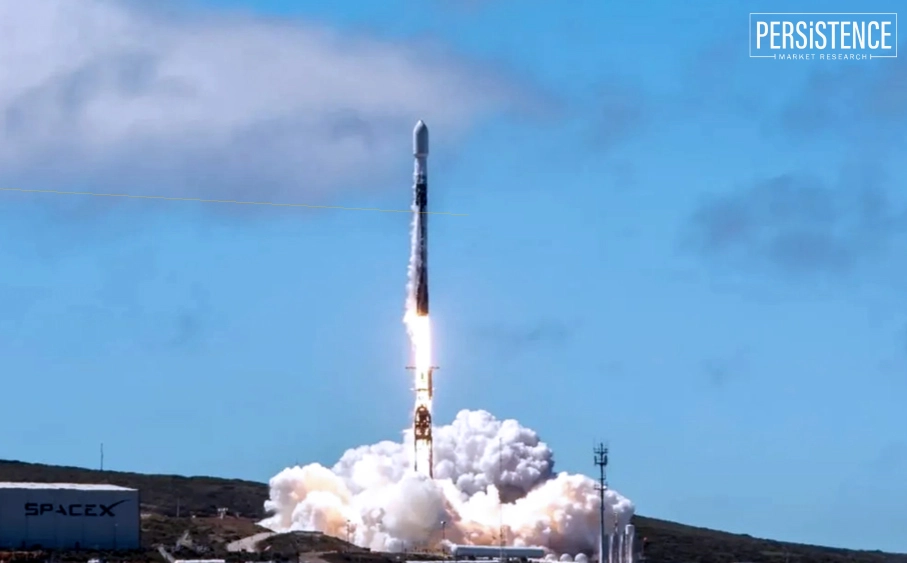- Blog
- Nasas Tracers Mission
NASA’s TRACERS Mission and Its Implications for Space Economy and Earth’s Digital Infrastructure
Published On : 24 Jul 2025
NASA launched TRACERS (Tandem Reconnection and Cusp Electrodynamics Reconnaissance Satellites), a space-weather observatory mission, on July 24, 2025, with a singular aim of deepening our understanding of how solar storms, which are massive bursts of energy from the Sun, interact with the Earth’s protective magnetic shield. At first glance, this might appear as a purely scientific endeavor but the mission is highly consequential for our world. Digging deeper, it becomes clear that TRACERS isn't just about decoding solar activity. In essence, it's about protecting the digital backbone of the modern human society.

Why TRACERS is Much Closer to Home than It Seems
We have built a world where much of our daily life is tethered to satellites, whether it's GPS navigation, high-speed internet, or even uninterrupted access to stable electricity. Given how heavily dependent we are on space-based technologies, our vulnerability quotient to disruptions from space weather will always remain heightened. That’s where TRACERS enters the picture.
While solar storms may seem straight from a science-fiction story, they are very much real, and history is witness on how tremendously damaging they can be. The blackout in Quebec that occurred in 1989 and the 2003 Halloween solar storms are grim reminders of what happens when charged solar particles interfere with Earth’s magnetic field. The economic implications of such events can be catastrophic. According to estimates released by the National Oceanic and Atmospheric Administration (NOAA), a major geomagnetic event today could cost the U.S. economy upwards of US$ 40 billion per day in damages and disruptions. The need to study, understand, and predict solar storms and similar events has become more urgent.
The TRACERS mission has been developed to address these growing concerns. The satellite system focuses on the polar cusp, a crucial area near Earth’s poles where solar particles can evade the magnetic defenses of our blue planet. These are magnetic reconnection events, which are processes during intense solar activity that temporarily weaken the protective magnetosphere enveloping the Earth, allowing solar energy to enter near-Earth space and potentially disrupt satellite communications, navigation, weather monitoring, aviation routes, and electrical grids. By observing such events more closely, TRACERS has been designed to ramp up our ability to predict and mitigate solar-driven disruptions.
How is TRACERS different from Other Solar Missions?
What puts TRACERS in different league from earlier missions is its dual-satellite structure. Instead of deploying a single spacecraft, NASA has launched a pair of satellites flying in tight coordination. This setup allows scientists to monitor changes in the magnetic field at multiple points in near real-time, offering a layered, more dynamic view of the data. One can draw parallels with watching a weather system evolve from different camera angles instead of just one, giving researchers much more data to work with. From the standpoint of growing space weather threats, more accurate, faster data can translate directly into the development of stronger, more pragmatic solutions like flat panel antennas for safeguarding the tech we rely on every day.
Why the Market Should be Paying Attention?
Beyond its scientific value, TRACERS is likely to spark considerable interest in advancing space-tech innovation, regulation, and risk strategy. One area that space companies and startups can explore with much alacrity is space weather forecasting. Some already have an established presence in this domain.
For example, in April 2025, Mission Space and Star Catcher Industries joined forces to elevate capabilities in real-time outer space weather monitoring and engineering orbital power solutions, with the former providing real-time space weather data and predictive models to support Star Catcher's orbital power grid, which beams additional power to Mission Space’s satellites. This is also an area that presents wide potential for research as well.
In July 2025, for instance, researchers at Chiba University in Japan achieved a breakthrough by developing a soft X-ray imaging technique that massively enhances space weather forecasting by accurately measuring magnetic reconnection rates in Earth's magnetosphere. The approach involves remotely detecting soft X-rays emitted when solar wind ions collide with neutral hydrogen atoms escaping Earth's atmosphere.
The high-fidelity data received from TRACERS could supercharge the development of such advanced space-weather models, opening novel revenue streams for companies working in AI-driven analytics, satellite monitoring, and Earth observation.
In addition to the above, the criticality of the mission can have a profound impact on investments in radiation-hardened electronics for the space environment and robust satellite infrastructure. Radiation-tolerant and radiation-hardened components are imperative for reliable space power systems exposed to harmful space radiation.
Radiation-tolerant parts suit less severe environments such as low Earth orbit (LEO), tolerating moderate radiation levels with cost-efficient designs for shorter missions. Radiation-hardened parts are built for harsher environments, mainly medium Earth orbit (MEO) and geostationary orbit (GEO), and deep space, enduring much higher radiation doses with robust packaging and rigorous testing to prevent mission failure. Choosing between them depends on mission type, orbit, radiation levels, and duration, balancing performance and cost for safe, durable space operations. With the sprawling LEO satellite constellations fast becoming the cornerstone of global communications, developing components that can withstand intense radiation in outer space is an excellent business opportunity lying in wait for private space entities.
What Lies Ahead?
Although TRACERS is a one-year mission, it can have substantial ripple effects could shape the next decade of research and innovation in space and satellite infrastructure.
What this mission could encourage is synergies between public and private organizations, which are already making notable headway. One instance of such collaboration occurred in 2023 when Fujitsu partnered with Tokai National Higher Education and Research System (THERS) to address major space weather risks by combining academic expertise with cutting-edge technology. THERS includes Nagoya University's Institute for Space-Earth Environmental Research (ISEE), renowned for creating the world's first precise solar flare prediction model.
The TRACERS is likely to spur more such public-private partnerships in the future. With solar activity expected to peak in this solar cycle, and climate resilience gaining boardroom relevance, space weather is no longer a distant, apocalyptic scientific concern. It’s a business and governance priority.
Industry Report

Request Report Sample
Your privacy is important to us; your data is secure
Contact Us
Latest Reports
-
Piezoresistive Pressure Sensor Market by Sensor Type (Absolute, Gauge, Differential, Sealed), Pressure Range (Low Pressure (<10 kPa), Medium Pressure (10 kPa – 1000 kPa), High Pressure (>1000 kPa)), End-Use Industry (Automotive & Transportation, Industrial Manufacturing, Healthcare, Aerospace & Defense, Electronics) and Regional Analysis for 2026-2033
-
Aquarium Accessories Market by Product Type (Filtration Items, Lights & Hoods, Temperature Control Systems, Others), End-User (Residential, Commercial), Distribution Channel (Online, Offline), and Regional Analysis for 2026-2033
-
Oxygen Therapy Market by Product Type (Compressed Oxygen, Concentrated Oxygen, Liquid Oxygen), Disease (Respiratory Disorder, Cardiovascular Disease, Sleep Apnea, Pneumonia), End-User (Hospitals, Home Healthcare, Clinics), and Regional Analysis for 2026-2033
-
Air Curtains Market by Product Type (Non‑Recirculating, Recirculating, Heated, Others), Airflow Capacity (Up to 500 m³/h, 500–1000 m³/h, 1000–1500 m³/h, Above 1500 m³/h), Application (Commercial, Industrial, Residential, Others), and Regional Analysis for 2026–2033
-
Personalized Stationery Market by Product type (Storage & Filling Products, Paper-Based Products, Drawing & Writing Instruments, Accessories, Bags, Others), Application (Educational Institutes, Corporate Offices, Personal Use, Hospitals, Others), and Regional Analysis for 2026–2033
